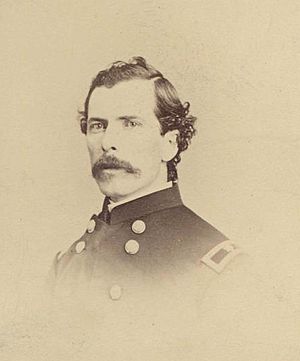Patrick Henry Jones facts for kids
Quick facts for kids
Patrick H. Jones
|
|
|---|---|

Jones circa 1860–1870
|
|
| Born | November 20, 1830 County Westmeath, Ireland
|
| Died | July 23, 1900 (aged 69) Port Richmond, New York, US
|
| Resting place | St. Peter's Cemetery, West New Brighton, New York |
| Nationality | Irish-American |
| Occupation | Lawyer, public servant and postmaster |
| Known for | Served as New York City postmaster from 1869–1872; an officer in the "Irish Rifles" and "Hardtack regiment" during the American Civil War |
| Political party | Republican |
| Children | 4 sons |
Patrick Henry Jones (born November 20, 1830 – died July 23, 1900) was an American lawyer and public servant. He served as the Postmaster of New York City in the late 1800s.
Jones also had an impressive military career. He fought for the Union Army during the American Civil War. He was part of many major battles and became a brigadier general. He was one of only a few Irish-American officers to reach such a high rank.
Contents
Biography
Early Life and Becoming a Lawyer
Patrick Henry Jones was born in Clonmellon, County Westmeath, Ireland, on November 20, 1830. He went to school in Dublin for three years. In 1840, when he was ten, his family moved to the United States. They settled on a farm in Cattaraugus County, New York.
Because his family was not wealthy, Patrick had limited schooling. He attended the Union School in Ellicottville. In 1850, at age 20, he started working in journalism. He traveled as a reporter for a major New York newspaper. Later, he became an editor for local newspapers in Buffalo.
Jones decided to become a lawyer. He studied law and was allowed to practice in 1856. He became a partner in a law firm in Ellicottville. By 1860, he was a well-known lawyer in western New York. He had always been a Democrat. However, he disagreed with the party's support for Southern states leaving the Union. In May 1861, he decided to join the military to defend the United States.
Military Service: A Brave General
When the American Civil War began, Jones joined the Union Army. On July 7, 1861, he joined the 37th New York Volunteer Infantry Regiment. This group was known as the "Irish Rifles." He started as a private but was quickly chosen by his fellow soldiers to be a second lieutenant.
He was at the First Battle of Bull Run but did not fight. Jones showed great bravery and quickly moved up in rank. By January 1862, he was a major. He and the "Irish Rifles" fought in many battles. These included Williamsburg, Seven Pines, and the Seven Days campaign. He was also at the Second Battle of Bull Run.
In October 1862, Jones became a colonel. He was put in charge of the 154th New York Volunteer Infantry Regiment. This group was called the "Hardtack regiment." His unit fought in the Battle of Chancellorsville. During this battle, Jones was wounded in his hip and captured by Confederate soldiers.
He was a prisoner-of-war for five months. After being released, he returned to duty. His unit then moved to Tennessee. They were at Chattanooga during the Battle of Missionary Ridge.
In April 1864, Jones took a break to recover his health. He then took command of a brigade during the Atlanta campaign. He also led his troops during Sherman's March to the Sea and the Carolinas campaign. He was injured again when his horse fell off a cliff. He recovered and returned to command. He was present when Confederate General Joseph E. Johnston surrendered in March 1865.
On April 18, Jones was promoted to brigadier general. This promotion was recommended by famous Generals Joseph Hooker and Oliver Howard. President Abraham Lincoln approved it after General William T. Sherman praised Jones's bravery. Jones stayed at this rank until he left the army on June 17, 1865.
Public Service and the Stewart Case
After the war, Jones went back to being a lawyer. In November 1865, he was elected as the Clerk of the New York Court of Appeals. He held this job until 1868. He was also appointed as the Register of New York City for a short time.
On April 1, 1869, President Ulysses S. Grant appointed Jones as the Postmaster of New York City. He served in this important role until 1872. From 1875 to 1877, he was again the Register of New York City. After that, he returned to his private law practice.
In 1877, Jones became involved in a strange case. The body of a wealthy man named Alexander Turney Stewart had been stolen. The people who took the body wanted money from Stewart's widow, Cornelia. They contacted Jones to help them talk to the Stewart family.
Jones reported the situation to the police. He agreed to help with the talks. The kidnappers sent him parts of Stewart's casket to prove they had the body. They demanded a large sum of money. Jones tried to negotiate for the body's return.
The first talks failed. A year later, Stewart's widow asked Jones to try again. Jones was able to get the kidnappers to agree to a much smaller amount of money. He then oversaw the delivery of the money and the safe return of Stewart's body.
Later Years and Passing Away
In his later years, Patrick Jones faced many health challenges. These problems were likely caused by his time in the war. He had pain from his old war wound and other ongoing issues.
His health slowly declined over the years. In early July 1900, he became very ill. Patrick Henry Jones passed away on July 18, 1900, at his home in Port Richmond, New York. His funeral was held at St. Mary's Church, and he was buried in St. Peter's Cemetery.

